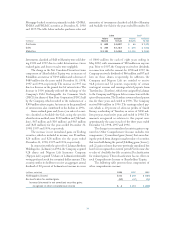American Express 1998 Annual Report Download - page 44
Download and view the complete annual report
Please find page 44 of the 1998 American Express annual report below. You can navigate through the pages in the report by either clicking on the pages listed below, or by using the keyword search tool below to find specific information within the annual report.
42
The Company uses derivative financial instruments for
nontrading purposes to manage its exposure to interest
and foreign exchange rates, financial indices and its fund-
ing costs. In addition, American Express Bank (AEB)
enters into derivative contracts both to meet the needs
of its clients and, to a limited extent, for proprietary
trading purposes.
There are a number of risks associated with deriv-
atives. Market risk is the possibility that the value of
the derivative financial instrument will change. The
Company is not exposed to market risk related to deriv-
atives held for nontrading purposes beyond that inherent
in cash market transactions. AEB is generally not subject
to market risk when it enters into a contract with a client,
as it usually enters into an offsetting contract or uses the
position to offset an existing exposure. AEB takes pro-
prietary positions within approved limits. These positions
are monitored daily at the local and headquarters levels
against Value at Risk (VAR) limits. The Company does
not enter into derivative contracts with features that
would leverage or multiply its market risk.
Credit risk related to derivatives and other off-
balance sheet financial instruments is the possibility that
the counterparty will not fulfill the terms of the contract.
It is monitored through established approval procedures,
including setting concentration limits by counterparty
and country, reviewing credit ratings and requiring col-
lateral where appropriate. For its trading activities with
clients, AEB requires collateral when it is not willing
to assume credit exposure to counterparties for either
contract mark-to-market or delivery risk. A significant
portion of the Company’s transactions are with counter-
parties rated A or better by nationally recognized credit
rating agencies. The Company also uses master netting
agreements which allow the Company to settle multiple
contracts with a single counterparty in one net receipt or
payment in the event of counterparty default. Credit risk
approximates the fair value of contracts in a gain posi-
tion (asset) and totaled $0.8 billion and $1.4 billion at
December 31, 1998 and 1997, respectively. The fair value
represents the replacement cost and is determined by mar-
ket values, dealer quotes or pricing models.
The following tables detail information regarding
the Company’s derivatives at December 31:
NOTE 7 DERIVATIVE AND OTHER OFF-BALANCE SHEET FINANCIAL INSTRUMENTS
NONTRADING 1998
Notional Carrying Value Fair Value
(millions) Amount Asset Liability Asset Liability
Interest Rate Products:
Interest rate swaps $ 13,548 $ 81 $ 72 $ 234 $ 174
Interest rate caps and floors purchased 7,025 17 — 21 1
Forward rate agreements 384————
Total Interest Rate Products 20,957 98 72 255 175
Foreign currency forward and spot contracts 5,965 49 52 59 54
Other Products 2,339 147 65 137 92
Total $ 29,261 $ 294 $ 189 $ 451 $ 321
PREFERRED SHARES
In January 1990, the Company sold four million of the
Company’s $3.875 Convertible Exchangeable Preferred
shares (Convertible Preferred shares) to Nippon Life for
$200 million. In May 1996, after receiving a redemp-
tion notice from the Company, Nippon Life converted
all of the Convertible Preferred shares into 4,705,882
of the Company’s common shares.
The Board of Directors is authorized to permit the
Company to issue up to 20 million preferred shares
without further shareholder approval.
























